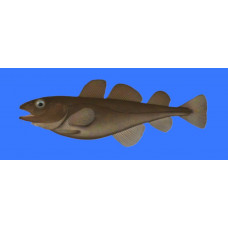Latin name
Gadus ogac
Other name
Gadus callarias marisalbi, Gadus maris-albi Iljin, Gadus morhua marisalbi, Gadus morhua ogac, Gadus ogac Richardson, Gadus ogat Krøyer, Gadus ovak Reinhardt.
Identification
Externally, the Greenland cod is similar to other cod species. Head is elongated and broad, 25.0-25.2% of body length, width of interorbital space 22.6-23.1% of head length. The upper jaw is elongated, 44.0-46.6% of the head length. Antenna shorter than diameter of eye. Caudal peduncle shortened and tall, 11.5-11.7% of body length, height 4.6-4.9% of same length. Horn-like protuberances on anterior margin of swim bladder usually short and curved toward midline with a slight bend at the end. Eyes are large, with the longitudinal diameter of the eye being 21.4-23.1% of the length of the head. Snout and jaws are elongated.
Features of fish fins
Body and unpaired fins Greenland cod high, rays of the 1st dorsal fin when pressed against the back go behind the beginning of the 2nd dorsal fin. Length of pectoral fin 15.3-16.0, length of pelvic fin 11.5-11.9, height of 1st dorsal fin 13.6-14.4, height of 1st anal fin 10.5-12.1.
Fish colouring
Greenland cod is dark in color, black-brown on top, lighter underneath with yellow marbled speckles. The tips of the unpaired fins are black, the pectoral and ventral fins are dark brown or black. Antennas are black, lateral line is dark.
Distribution
The range of this species includes the Arctic Ocean and northwestern Atlantic Ocean from Alaska to West Greenland, then south along the Canadian coast to the Gulf of St. Lawrence and Cape Breton Island, generally from 45 to 75 degrees north latitude.
Habitat
They are bottom-dwelling fish that inhabit coastal waters and continental shelves down to depths of 200 meters.
Size
Greenland cod can reach 77 cm in length. It grows much slower and reaches smaller size and older age than Atlantic cod. Commercial catches are dominated by 3-5 year old cod, 25-35 cm in length. The maximum age is 11 years.
Behavior
This species lingers and spawns near the shore.
Food and feeding habits
It feeds on fish and amphipods. During the spawning season, this species feeds on three-spined stickleback. During this time, the Greenland cod leads a pelagic lifestyle, rising to the surface after its prey. Their stomachs are full of stickleback. Later, their stomachs begin to contain a significant amount of stickleback eggs, and even later - in July - fry.
Reproduction
This cod spawns under ice at a temperature of -0.5-1.0° C.
Fishing
It is a commercially important fish used for food. But in recent years, its catch has decreased significantly.
Relationship with a person
Harmless.
| Classification | |
| Phylum | Chordata |
| Class | Actinopterygii |
| Squad | Gadiformes |
| Family | Gadidae |
| Genus | Gadus |
| Species | G. ogac |
| Features | |
| Conservation status | Not Evaluated |
| Habitat | Bottom |
| Life span, years | 11 |
| Maximum body weight, kg | No information |
| Maximum length, cm | 77 |
| Sailing speed, m/s | No information |
| Threat to people | Edible |
| Way of eating | Predator |
Greenland cod
Tags: greenland cod


